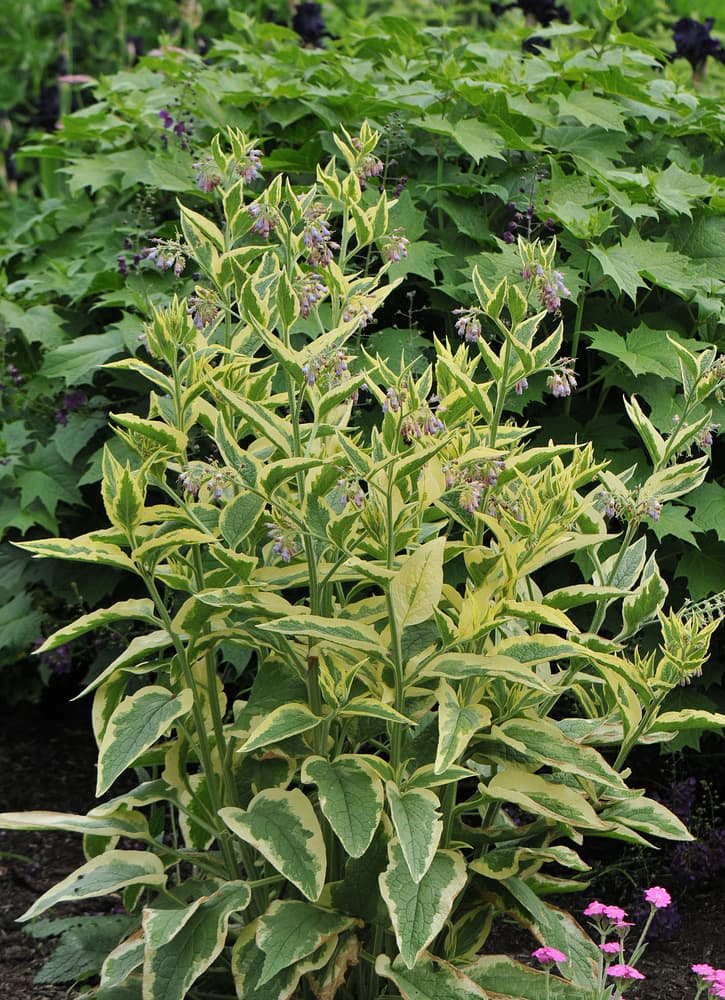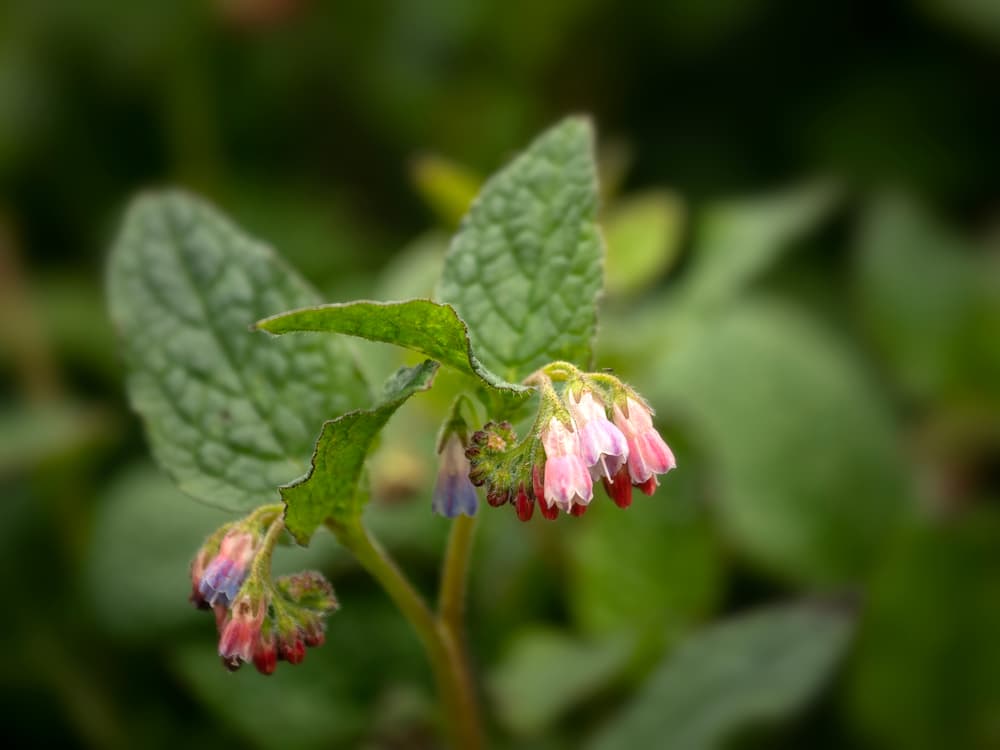PERENNIALS > COMFREY > VARIETIES
Reviewed By DAN ORI

Dan has over 27 years’ under his belt caring for plants and gardens. Working as a Horticultural Instructor and Consultant, he draws on a diverse range of experience that includes working as a Head Gardener, Tree Surgeon, Garden Centre Trouble Shooter, and writer of academic papers. Dan has a Level 3 Diploma in Horticulture and is currently a candidate for the RHS’s most prestigious award – The Master of Horticulture.
IN THIS GUIDE
COMFREY GUIDES
Comfrey vs Borage
Fertiliser
– For Tomatoes
Growing From Seed
Harvesting
Root Cuttings
Varieties
Comfrey, a member of the Borage Family, is made up of 35 different species, all belonging to Symphytum.1Comfrey (Genus Symphytum). (n.d.). iNaturalist United Kingdom. Retrieved March 14, 2023, from https://uk.inaturalist.org/taxa/55725-Symphytum
They attain heights of about 50-125cm.
The different species’ foliage occurs in somewhat different shades of green, including bright medium green, deep dark green, and glazed greyish-green.

However, all share a common distinctive feature in that the foliage – leaves, stalks and petioles – is visibly and palpably hairy.
The leaves, deeply etched with veins, are elliptical and 20-25cm in length.
Those of Symphytum officinale have a more pronounced elliptical shape than those of other varieties.

In May and June, the plants produce 1-2cm pendent flowers shaped like tubular bells.
In shades of cream, yellowish, lilac, purple or pink, they are sometimes bicoloured with the upper or basal half being white or off-white and the lower or outward half in some shade of blue, pink, or purple.
1) Common Comfrey

- BOTANICAL NAME: S. officinale
- FLOWER COLOUR: BLUE
- NATIVE AREA: UK; EUROPE
This variety has a clumping and spreading habit.
Its flowers are either cream or in a colour in the pink through purple spectrum.
This same species that produces blue flowers is identified by a specific name: S. officinale blue-flowered or Blue-Flowered Common Comfrey.
2) Caucasian Comfrey

- BOTANICAL NAME: S. caucasicum
- FLOWER COLOUR: LILAC-BLUE
- NATIVE AREA: Iran; Georgia; Eurasia
This plant has an erect habit and spreads rapidly.
It is native to Iran, Georgia and surrounding regions of Eurasia.2Comfrey (Caucasian). (n.d.). Wild Flower Finder. Retrieved March 14, 2023, from https://wildflowerfinder.org.uk/Flowers/C/Comfrey(Caucasian)/Comfrey(Caucasian).htm
It attains a height of about 60cm and bears lilac-blue flowers that are frequently pink as buds.
3) Dwarf Comfrey

- BOTANICAL NAME: S. grandiflorum
- FLOWER COLOUR: PINK
- NATIVE AREA: UK; EUROPE
A bushy habit and one of the less-invasive species.
It is native to the UK and Europe.3Symphytum grandiflorum. (n.d.). North Carolina Extension Gardener Plant Toolbox. Retrieved March 14, 2023, from https://plants.ces.ncsu.edu/plants/symphytum-grandiflorum/
It may reach a height of only about 40cm with a spread of 60cm.
Flowers are a rich cream shade but are an equally rich pink as buds.
4) Iberian Comfrey

- BOTANICAL NAME: S. ibericum
- FLOWER COLOUR: YELLOWISH-WHITE
- NATIVE AREA: TURKEY; THE CAUCASUS
Another dwarf species but has a spreading, branching habit.
It originates from Turkey and the surrounding Caucasus region.4Symphytum ibiricum. (n.d.). Kew Royal Botanic Gardens. Retrieved March 14, 2023, from https://powo.science.kew.org/taxon/urn:lsid:ipni.org:names:120793-1
It too reaches a height of about 40cm with a spread of about 60cm.
Its flowers are off-white or yellowish-white while the buds are rose-red.
5) Russian Comfrey

- BOTANICAL NAME: S. × uplandicum
- FLOWER COLOUR: MAGENTA
- NATIVE AREA: EUROPE; ASIA
Russian Comfrey is a sterile hybrid and, therefore, cannot self-seed – which greatly reduces the concern one has about comfrey’s invasiveness.
However, it exhibits very vigorous growth and, as such, can spread.
It can reach a height of nearly 2m and because of the overall size, this hybrid is a top choice for harvesting leaves for composting and other practical purposes.
Its flowers are among the most appealing too, being of a pretty purple-to-violet hue.
6) Comfrey ‘Bocking 14’

- BOTANICAL NAME: S. × uplandicum ‘Bocking 14’
- FLOWER COLOUR: PURPLE
- NATIVE AREA: CULTIVATED
A very popular variety and ‘the smart choice’.
The reason is that it carries all the advantages of the plant without any downside.
Like the parent hybrid, it is sterile and cannot self-seed but on top of that it is a well-behaved, non-invasive variety that does not spread so much.5Symphytum × uplandicum “Bocking 14.” (n.d.). Royal Horticultural Society. Retrieved March 14, 2023, from https://www.rhs.org.uk/plants/108577/symphytum-x-uplandicum-bocking-14/details
It reaches a height and spread of (only) about 1m and bears the same pretty purple-to-violet flowers as the parent hybrid.
7) Variegated Russian Comfrey

- BOTANICAL NAME: S. × uplandicum ‘Variegatum’
- FLOWER COLOUR: PINK; PURPLE
- NATIVE AREA: EUROPE; ASIA
This variety carries a different set of plusses.
It too is sterile and ‘well-behaved’ with a clumping, non-spreading habit.
It attains a height and spread of 80-100cm.
Like common comfrey, its flowers are in the pink through the purple spectrum.
Unlike common comfrey, its leaves are variegated, displaying fairly thick cream-yellow edging.
Did we say that comfrey plants are not at all ornamental? Oops!
“My top two picks are S. × uplandicum ‘Variegatum’ and S. × uplandicum ‘Bocking 14’,” shares Master Horticulturist Dan Ori.
“They stay under control but are still productive enough to produce plenty of leaves for making plant feed (comfrey tea).”
8) Comfrey Goldsmith
- BOTANICAL NAME: S. grandiflorum ‘Goldsmith’
- FLOWER COLOUR: PURPLE
- NATIVE AREA: THE CAUCASUS
This is the grandiflorum species’ contribution to comfrey ornamentation.
It has a bushy, clump-forming habit and is one of the dwarf varieties at about 40cm in height with a somewhat smaller spread.
The flowers are pastel purple at the basal or upper half and white at the lower or distal half.
The variegated leaves are a much brighter shade of green than other comfreys with an equally bright yellow, very broad and irregular, edging.
9) Comfrey Hidcote Pink

- BOTANICAL NAME: S. ‘Hidcote Pink’
- FLOWER COLOUR: CREAM; PINK
- NATIVE AREA: EUROPE
Has a bushy, clump-forming habit and it does not get out of hand as much as a few of the species can.
Its height is as tidy as its habit, being only 40-50cm.
Its bicoloured flowers are cream at the basal end and a rich bright pink on the outer or distal half.
It has an earlier blooming season than other comfreys.

S. ‘Hidcote Blue’ is a variant that bears blue-to-purple flowers.
References
- 1Comfrey (Genus Symphytum). (n.d.). iNaturalist United Kingdom. Retrieved March 14, 2023, from https://uk.inaturalist.org/taxa/55725-Symphytum
- 2Comfrey (Caucasian). (n.d.). Wild Flower Finder. Retrieved March 14, 2023, from https://wildflowerfinder.org.uk/Flowers/C/Comfrey(Caucasian)/Comfrey(Caucasian).htm
- 3Symphytum grandiflorum. (n.d.). North Carolina Extension Gardener Plant Toolbox. Retrieved March 14, 2023, from https://plants.ces.ncsu.edu/plants/symphytum-grandiflorum/
- 4Symphytum ibiricum. (n.d.). Kew Royal Botanic Gardens. Retrieved March 14, 2023, from https://powo.science.kew.org/taxon/urn:lsid:ipni.org:names:120793-1
- 5Symphytum × uplandicum “Bocking 14.” (n.d.). Royal Horticultural Society. Retrieved March 14, 2023, from https://www.rhs.org.uk/plants/108577/symphytum-x-uplandicum-bocking-14/details


